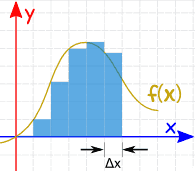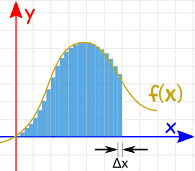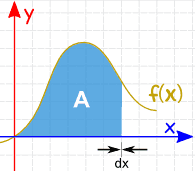what does it mean to take an integral
Introduction to Integration
Integration is a manner of adding slices to find the whole.
Integration can be used to find areas, volumes, central points and many useful things. But it is easiest to start with finding the area between a office and the 10-centrality like this:

What is the surface area?
Slices
| We could calculate the office at a few points and add together up slices of width Δx like this (simply the respond won't be very accurate): |  | |
| We tin make Δx a lot smaller and add upward many small slices (answer is getting better): |  | |
| And every bit the slices arroyo nil in width, the answer approaches the true answer. Nosotros now write dx to mean the Δx slices are budgeted zero in width. |  |
That is a lot of adding up!
But we don't have to add them upwards, as at that place is a "shortcut", considering ...
... finding an Integral is the opposite of finding a Derivative.
(So you should really know about Derivatives earlier reading more!)
Like here:
Example: 2x
An integral of 2x is x2 ...

... because the derivative of x2 is 2x
(More than about "+C" later.)
That elementary example tin can be confirmed by calculating the area:

Area of triangle = 1 two (base)(acme) = 1 2 (x)(2x) = tenii
Integration can sometimes be that easy!
Notation
| The symbol for "Integral" is a stylish "S" |  |
After the Integral Symbol we put the function nosotros desire to observe the integral of (called the Integrand),
and so finish with dx to mean the slices become in the x direction (and arroyo zero in width).
And hither is how nosotros write the answer:

Plus C
We wrote the reply every bit 10ii merely why +C ?
Information technology is the "Constant of Integration". It is there because of all the functions whose derivative is 2x:

- the derivative of 102 is 2x,
- and the derivative of xtwo+4 is likewise 2x,
- and the derivative of x2+99 is besides 2x,
- and then on!
Because the derivative of a constant is zero.
So when we reverse the operation (to find the integral) we only know 2x, but there could have been a constant of any value.
Then we wrap up the thought past just writing + C at the cease.
A Practical Example: Tap and Tank

Permit u.s. use a tap to fill a tank.
The input (before integration) is the catamenia rate from the tap.
We can integrate that flow (add up all the little bits of water) to give us the volume of water in the tank.
Imagine a Constant Flow Rate of i:

An integral of 1 is ten
With a flow charge per unit of 1 liter per second, the volume increases by 1 liter every second, so would increase by 10 liters after 10 seconds, threescore liters later on 60 seconds, etc.
The menses rate stays at 1, and the book increases past x
And information technology works the other mode besides:
If the tank volume increases past 10, then the flow charge per unit must be 1.
The derivative of x is one
This shows that integrals and derivatives are opposites!

Now For An Increasing Flow Rate
Imagine the flow starts at 0 and gradually increases (maybe a motor is slowly opening the tap):

As the flow rate increases, the tank fills upwards faster and faster:
- Integration: With a menstruation rate of 2x, the tank book increases by x2
- Derivative: If the tank volume increases by ten2 , so the flow rate must be 2x

We can write information technology downwards this way:
| The integral of the period rate 2x tells us the book of water: | ∫2x dx = xtwo + C | |
| The derivative of the volume 102+C gives usa back the flow rate: | d dx (xii + C) = 2x |

And hey, we fifty-fifty get a nice explanation of that "C" value ... mayhap the tank already has water in it!
- The flow nonetheless increases the volume by the same amount
- And the increment in volume tin give us back the menstruation charge per unit.
Which teaches united states of america to always think "+C".
Other functions
How do we integrate other functions?
If nosotros are lucky enough to find the function on the result side of a derivative, then (knowing that derivatives and integrals are opposites) nosotros take an respond. But call back to add C.
Example: what is ∫cos(x) dx ?

From the Rules of Derivatives table we see the derivative of sin(x) is cos(ten) and then:
∫cos(x) dx = sin(10) + C
Simply a lot of this "reversing" has already been done (see Rules of Integration).
Example: What is ∫x3 dx ?
On Rules of Integration there is a "Power Rule" that says:
∫10n dx = xn+1 n+one + C
We can use that rule with n=three:
∫xthree dx = x4 four + C
Knowing how to use those rules is the central to being good at Integration.
So learn the rules and become lots of practice.
Learn the Rules of Integration and Practice! Practice! Practice!
(there are some questions below to become y'all started)
Definite vs Indefinite Integrals
We have been doing Indefinite Integrals so far.
A Definite Integral has bodily values to calculate between (they are put at the bottom and top of the "S"):
Read Definite Integrals to learn more.
Source: https://www.mathsisfun.com/calculus/integration-introduction.html
0 Response to "what does it mean to take an integral"
Post a Comment